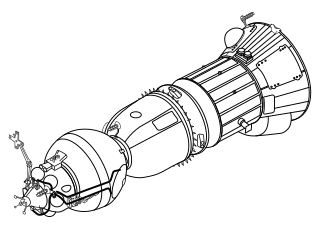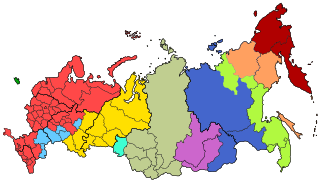
Soyuz 1 was a manned spaceflight of the Soviet space program. Launched into orbit on 23 April 1967 carrying cosmonaut Colonel Vladimir Komarov, Soyuz 1 was the first crewed flight of the Soyuz spacecraft. The flight was plagued with technical issues, and Komarov was killed when the descent module crashed into the ground due to a parachute failure. This was the first in-flight fatality in the history of spaceflight.

Soyuz is a family of expendable launch systems developed by OKB-1 and manufactured by Progress Rocket Space Centre in Samara, Russia. With over 1700 flights since its debut in 1966, the Soyuz is the most frequently used launch vehicle in the world.

The R-7 was a Soviet missile developed during the Cold War, and the world's first intercontinental ballistic missile. The R-7 made 28 launches between 1957 and 1961, but was never deployed operationally. A derivative, the R-7A, was deployed from 1959 to 1968. To the West it was known by the NATO reporting name SS-6 Sapwood and within the Soviet Union by the GRAU index 8K71. In modified form, it launched Sputnik 1, the first artificial satellite, into orbit, and became the basis for the R-7 family which includes Sputnik, Luna, Molniya, Vostok, and Voskhod space launchers, as well as later Soyuz variants.
Soyuz 7K-T No.39, was an unsuccessful launch of a manned Soyuz spacecraft by the Soviet Union in 1975. The mission was expected to dock with the orbiting Salyut 4 space station, but due to a failure of the Soyuz launch vehicle the crew failed to make orbit. The crew consisted of commander Vasily Lazarev, and flight engineer Oleg Makarov, a civilian. Although the mission was aborted and did not accomplish its objective, the craft exceeded the Karman line altitude of 100 kilometers and therefore reached a suborbital spaceflight, which the crew survived. The crew, who initially feared they had landed in China, were successfully recovered.

The Apollo spacecraft was composed of three parts designed to accomplish the American Apollo program's goal of landing astronauts on the Moon by the end of the 1960s and returning them safely to Earth. The expendable (single-use) spacecraft consisted of a combined command and service module (CSM) and an Apollo Lunar Module (LM). Two additional components complemented the spacecraft stack for space vehicle assembly: a spacecraft–LM adapter (SLA) designed to shield the LM from the aerodynamic stress of launch and to connect the CSM to the Saturn launch vehicle; and a launch escape system (LES) to carry the crew in the command module safely away from the launch vehicle in the event of a launch emergency.
The N1, or Н1 in Russian, was a super heavy-lift launch vehicle intended to deliver payloads beyond low Earth orbit. The N1 was the Soviet counterpart to the US Saturn V and was intended to enable crewed travel to Earth's Moon and beyond, with studies beginning as early as 1959. Its first stage remains the most powerful rocket stage ever built, but all of the four flown N1 first stages failed.
Soyuz 7K-ST No.16L, sometimes known as Soyuz T-10a or T-10-1, was an unsuccessful Soyuz mission intended to visit the Salyut 7 space station, which was occupied by the Soyuz T-9 crew. However, it never finished its launch countdown; the launch vehicle was destroyed on the launch pad by fire on September 26, 1983. The launch escape system of the Soyuz spacecraft fired two seconds before the launch vehicle exploded, saving the crew. It is the first case in which a launch escape system has been fired with a crew on board.
Kosmos 140 was an unmanned flight of the Soyuz spacecraft. It was the third attempted test flight of the Soyuz 7K-OK model, after orbital and launch failures of the first two Soyuz spacecraft.
During the launch of an Apollo spacecraft by the Saturn IB or Saturn V rocket, the flight could be aborted to rescue the crew if the rocket failed catastrophically. Depending on how far the flight had progressed, they would use different procedures or modes. None of these launch abort modes was ever used on any of the fifteen crewed Apollo spacecraft flights.

A launch escape system (LES) or launch abort system (LAS) is a crew safety system connected to a space capsule, used to quickly separate the capsule from its launch vehicle rocket in case of a launch abort emergency, such as an impending explosion. The LES is typically controlled by a combination of automatic rocket failure detection, and a manual activation for the crew commander's use. The LES may be used while the launch vehicle is still on the launch pad, or during its ascent. Such systems are usually of two types:

Zenit was a series of military photoreconnaissance satellites launched by the Soviet Union between 1961 and 1994. To conceal their nature, all flights were given the public Kosmos designation.

The Soyuz-U launch vehicle was an improved version of the original Soyuz rocket. Soyuz-U was part of the R-7 family of rockets based on the R-7 Semyorka missile. Members of this rocket family were designed by the TsSKB design bureau and constructed at the Progress Factory in Samara, Russia. The first Soyuz-U flight took place on 18 May 1973, carrying as its payload Kosmos 559, a Zenit military surveillance satellite. The final flight of a Soyuz-U rocket took place on February 22, 2017, carrying Progress MS-05 to the International Space Station.

The Orion Multi-Purpose Crew Vehicle is a US-European spacecraft intended to carry a crew of four astronauts to destinations at or beyond low Earth orbit (LEO). Like the Apollo command and service module (CSM), the Orion MPCV will use the launch escape system (LES), a solid-fueled tractor rocket that will be able to pull the Orion crew module away from a malfunctioning Space Launch System (SLS) rocket during the initial launch phase. Based on the launch escape system found on the Soviet/Russian Soyuz spacecraft, the LAS, designed and manufactured by ATK for the Orion MPCV, is larger than the Soyuz version and will have more thrust than the Atlas 109-D booster that carried astronaut John Glenn into orbit in 1962.
Foton-M No.1 was an unmanned space mission by the European Space Agency aboard a Russian Soyuz-U rocket that failed to launch successfully. The spacecraft's payload consisted of 44 experiments prepared by the European Space Agency, Fluidpac, BIOPAN-4, Telescience Support Unit, and others. The mission was supposed to consist of 15 days spent in orbit of the Earth and then re-enter for a landing near the Russia-Kazakhstan border.

The Soyuz 7K-LOK, or simply LOK was a Soviet crewed spacecraft designed to launch men from Earth to orbit the Moon, developed in parallel to the 7K-L1. The LOK would carry two cosmonauts, acting as a mother ship for the LK Lander which would land one crew member to the surface. It was part of the N1-L3 programme which also included the LK lander and the N1 rocket.

The Soyuz 7K-L1 "Zond" spacecraft was designed to launch men from the Earth to circle the Moon without going into lunar orbit in the context of the Soviet crewed Moon-flyby program in the Moon race. It was based on the Soyuz 7K-OK. Several modifications reduced vehicle mass and increased circumlunar capability. The most notable modifications were the replacement of the orbital module with a support cone and a high-gain parabolic antenna, the removal of a reserve parachute, and the addition of the gyro platform and star navigation sensors for the far space navigation. The spacecraft was capable of carrying two cosmonauts. At the start of flight testing, there were serious reliability problems with the new Proton rocket, the 7K-L1, and the Soyuz 7K-OK that the L1 was based on.

The Soyuz was a Soviet expendable carrier rocket designed in the 1960s by OKB-1 and manufactured by State Aviation Plant No. 1 in Kuybyshev, Soviet Union. It was commissioned to launch Soyuz spacecraft as part of the Soviet human spaceflight program, first with 8 uncrewed test flights, followed by the first 19 crewed launches. The original Soyuz also propelled four test flights of the improved Soyuz 7K-T capsule between 1972 and 1974. In total it flew 30 successful missions over 10 years and suffered two failures.

The Atlas LV-3B, Atlas D Mercury Launch Vehicle or Mercury-Atlas Launch Vehicle, was a human-rated expendable launch system used as part of the United States Project Mercury to send astronauts into low Earth orbit. Manufactured by American aircraft manufacturing company Convair, it was derived from the SM-65D Atlas missile, and was a member of the Atlas family of rockets.

Soyuz MS-10 was a manned Soyuz MS spaceflight which aborted shortly after launch on 11 October 2018 due to a failure of the Soyuz-FG launch vehicle boosters. MS-10 was the 139th flight of a Soyuz spacecraft. It was intended to transport two members of the Expedition 57 crew to the International Space Station. A few minutes after liftoff, the craft went into contingency abort due to a booster failure and had to return to Earth. By the time the contingency abort was declared, the launch escape system (LES) tower had already been ejected and the capsule was pulled away from the rocket using the launch escape solid rocket motors on the capsule fairing. Both crew members, Roscosmos cosmonaut Aleksey Ovchinin and NASA astronaut Nick Hague, were recovered alive and in good health. The MS-10 flight abort was the first instance of a Russian manned booster accident in 35 years, since Soyuz T-10-1 exploded on the launch pad in September 1983. On 1 November 2018, Russian scientists released a video recording of the mission.














